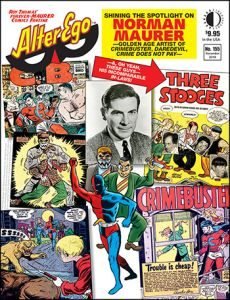Alter Ego #155 November 2018 (magazine review).
I have to confess to not knowing much about comicbook artist and writer Norman Maurer (1926-1986) but with Richard Arndt’s interview with his widow, Joan, I learnt a lot. Joan, by the way is the daughter of Moe Howard and the connection to ‘The Three Stooges’ should slap you on the face considering Maurer drew two series of comics featuring them later as well. However, Maurer did far more in his career and was a pal of Joe Kubert, having trained together. The main difference is that Maurer also became an agent to the Stooges themselves, a film producer, director and scriptwriter, and scripted animation. One of his sons is also in the animation industry. Joan has still got lots of his art and comics and so you get a lot of samples here showing how versatile he was.
If you want to have name confusion, tracking Maddy Cohen back to her comicbook writer’s name as Mimi Gold, a name suggested by Jim Steranko who thought her real name Miriam Goldenberg less saleable. Obviously, the interview focuses a lot more on that part of her career. Always a writer, she got her foot through the door at Marvel when Stan Lee needed a secretary but quickly moved over to the editing department and later moved to DC Comics and Warren Publications. She makes a potent comment that the Goodmans at Marvel were acknowledged ‘cheapsters of the industry’.
Another confession, I found this section of John Broom’s life story totally confusing as he explores his life in Paris in the 1960s.
However, the now late Larry Ivie’s look at when National Periodicals/DC Comics also had a separate division called ‘All-American’, which carried the Justice Society Of America stories before they came under one umbrella company name. I was surprised how he described Hawkman’s mask as being popular considering my previous comments that it was a mask that only had two good positions to draw from. Indeed, enough so that high schools actually made Hawk-masks and seeing a photo of one of these here is impressive.
Under Michael T. Gilbert’s ‘Mr. Monster’ column, we have the two letters that comicbook artist and inker Dan Atkins in 1969 replied to Modern Collector’s Review (MCR) about his swiping which is illuminating as he points out he wasn’t the only one and if anything, it was because he had a smaller selection to choose from that he got caught out although its nothing new in the industry. I did find it interesting that many of them used UK’s ‘The Eagle’ as source material. If they’re referring to the Hampton material, he in turn had people posing. From a painting pov, every time something is based off a photograph, it is a form of swiping, although no indication how ‘The Eagle’ got imported to the USA at that time. Atkins really made me think here. I mean, any artist who copies a photo is essentially swiping. Re-interpreting the pose into something else at least takes it one stage away from that. With painting, it is still down to interpretation and colour choices that makes it seem as an artistic endeavour. It’s only when an artist defines the paint strokes to photo-real that there is a problem. I mean, why buy a painting of that accuracy when the photo is cheaper?
Raymond Miller (1931-2017) has an interview with him about his early collecting days from the early 1940s on which gives some insight into how little things have changed, although I doubt if I’d put any of my comics up on a stand to admire their covers over the winter. There are also obituaries of editor/writer Bill Harris (1934-2018) and artist Fran Hopper (1922-2017). I came across Fran Hopper in Martha Kennedy’s book ‘Drawn To Purpose’ that I reviewed earlier in the year.
Finally, a look at the career of writer France ‘Ed’ Herror (1917-1966) who worked for most of the comicbook companies before dying of colon cancer. For Simon & Kirby, he created the Red Skull for Captain America in 1941. At Fawcett, he created Captain Marvel, Jr. although I do have to wonder at Freddy Freeman having to say Captain Marvel’s name to transform because he can hardly call his saviour by his full name anymore without flipping through his human and super-human modes. Then again, how did the three Lieutenant Marvels know that Billy Batson was Captain Marvel?
As always, ‘Alter Ego’ is a learning experience and the prime source of early American comicbooks and always adds to my knowledge.
GF Willmetts
November 2018
(pub: TwoMorrows Publishing. 100 page illustrated magazine. Price: $ 9.95 (US). ISSN: 1932-6890. Direct from them, you can get it for $ 8.46 (US))
check out websites: www.TwoMorrows.com and http://twomorrows.com/index.php?main_page=product_info&cPath=98_55&products_id=1370






